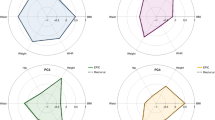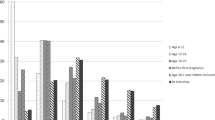Abstract
Objective:
To investigate the association between various anthropometric characteristics and breast cancer.
Design:
Longitudinal prospective cohort study. Follow-up between 1995 and 2000.
Subjects:
In total, 69 116 women (age: 45–70 years; mean follow-up: 3.6 years), 275 premenopausal and 860 postmenopausal incident invasive breast cancers.
Measurements:
Self-reported height, weight, breast, thorax, waist and hip circumferences and calculated body mass index (BMI) and waist-to-hip ratio (WHR) at baseline.
Results:
A slight increase in risk with increasing height was found. Weight, BMI, thorax and waist circumferences and WHR were negatively related to breast cancer risk among premenopausal women. The relationships became non significant after additional adjustment for BMI. An increased risk of premenopausal breast cancer with an android body shape (WHR>0.87) might possibly be confined to obese women. Among postmenopausal women, all anthropometric measurements of corpulence were positively associated with breast cancer risk but became non significant after additional adjustment for BMI. No difference in risk of postmenopausal breast cancer according to HRT use was observed.
Conclusion:
The study confirmed that adiposity was negatively associated to premenopausal breast cancer risk and positively associated to postmenopausal breast cancer risk. Further studies will be needed to specify clearly the association between WHR and breast cancer risk, particularly before menopause.
This is a preview of subscription content, access via your institution
Access options
Subscribe to this journal
Receive 12 print issues and online access
$259.00 per year
only $21.58 per issue
Buy this article
- Purchase on Springer Link
- Instant access to full article PDF
Prices may be subject to local taxes which are calculated during checkout
Similar content being viewed by others
References
World Cancer Research Fund/American Institute for Cancer Research. Food, Nutrition and the Prevention of Cancer: a Global Perspective 1997; 252–288.
van den Brandt PA, Spiegelman D, Yaun SS, Adami HO, Beeson L, Folsom AR et al. Pooled analysis of prospective cohort studies on height, weight, and breast cancer risk. Am J Epidemiol 2000; 152: 514–527.
Friedenreich CM . Review of anthropometric factors and breast cancer risk. Eur J Cancer Prev 2001; 10 (1): 15–32.
IARC Handbooks of Cancer Prevention. Weight Control and Physical Activity, vol. 6. IARC press, Lyon, France, 2002.
Kaaks R . Nutrition, hormones, and breast cancer: is insulin the missing link? Cancer Causes Control 1996; 7: 605–625.
Connolly BS, Barnett C, Vogt KN, Li T, Stone J, Boyd NF . A meta-analysis of published literature on waist-to hip ratio and risk of breast cancer. Nutr Cancer 2002; 44 (2): 127–138.
Clavel-Chapelon F, the E3N-EPIC Group. Differential effects of reproductive factors on the risk of pre- and post-menopausal breast cancer. Results from a large cohort of French women. Br J Cancer 2002; 4: 723–727.
Korn EL, Graubard BI, Midthune D . Time-to-event analysis of longitudinal follow-up of a survey: choice of time-scale. Am J Epidemiol 1997; 145: 72–80.
WHO Expert Committee. Physical Status. The Use and Interpretation of Anthropometry. WHO: Geneva, 1995.
Hirose K, Tajima K, Hamajima N, Takezaki T, Inoue M, Kuroishi T et al. Effect of body size on breast-cancer risk among Japanese women. Int J Cancer 1999; 80 (3): 349–355.
Tung HT, Tsukuma H, Tanaka H, Kinoshita N, Koyoma Y, Ajiki W et al. Risk factors for breast cancer in Japan, with special attention to anthropometric measurements and reproductive history. Jpn J Clin Oncol 1999; 29 (3): 137–146.
Shu XO, Jin F, Dai Q, Rong Shi J, Potter JD, Brinton LA et al. Association of body size and fat distribution with risk of breast cancer among Chinese women. Int J Cancer 2001; 94 (3): 449–455.
Wenten M, Gilliland FD, Baumgartner K, Samet JM . Associations of weight, weight change, and body mass with breast cancer risk in Hispanic and non-Hispanic white women. Ann Epidemiol 2002; 12 (6): 435–444.
Lahmann PH, Lissner L, Gullberg B, Olsson H, Berglund G . A prospective study of adiposity and post-menopausal breast cancer risk: the Malmo diet and Cancer Study. Int J Cancer 2003; 103 (2): 246–252.
Friedenreich CM, Courneya KS, Bryant HE . Case-control study of anthropometric measures and breast cancer risk. Int J Cancer 2002; 99 (3): 445–452.
Mannistö S, Pietinen P, Pyy M, Palmgren J, Eskelinen M, Uusitupa M . Body-size indicators and risk of breast cancer according to menopause and estrogen-receptors status. Int J cancer 1996; 68: 8–13.
Muti P, Stanulla M, Micheli A, Krogh V, Freudenheim JL, Yang J et al. Markers of insulin resistance and sex steroid hormone activity in relation to breast cancer risk: a prospective analysis of abdominal adiposity, sebum production, and hirsutism (Italy). Cancer Causes Control 2000; 11 (8): 721–730.
Kaaks R, Lundin E, Rinaldi S, Manjer J, Biessy C, Soderberg S et al. Prospective study of IGF-I, IGF-binding proteins, and breast cancer risk, in northern and southern Sweden. Cancer Causes Control 2002; 13 (4): 307–316.
Kalme T, Koistinen H, Loukovaara M, Koistinen R, Leinonen P . Comparative studies on the regulation of insulin-like growth factor-binding protein-1 (IGFBP-1) and sex hormone-binding globulin (SHBG) production by insulin and insulin-like growth factors in human hepatoma cells. J Steroid Biochem Mol Biol 2003; 86: 197–200.
Kaaks R, Bellati C, Venturelli E, Rinaldi S, Secreto G, Biessy C et al. Effects of dietary intervention on IGF-I and IGF-binding proteins, and related alterations in sex steroid metabolism: the diet and androgens (DIANA) randomised trial. Eur J Clin Nutr 2003; 57: 1079–1088.
Key TJ, Appleby PN, Reeves GK, Roddam A, Dorgan JF, Longcope C et al. Body mass index, serum sex hormones, and breast cancer risk in postmenopausal women. J Natl Cancer Inst 2003; 95: 1218–1226.
De Ridder CM, Bruning PF, Zonderland ML, Thijssen JH, Blankenstein MA, Huisveld IA et al. Body fat mass, body fat distribution, and plasma hormones in early puberty in females. J Clin Endocrinol Metab 1990; 70 (4): 888–893.
Sellers TA, Davis J, Cerhan JR, Vierkant RA, Olson JE, Pankratz VS et al. Interaction of waist/hip ratio and family history on the risk of hormone receptor-defined breast cancer in a prospective study of post-menopausal women. Am J Epidemiol 2002; 155 (3): 225–233.
Huang Z, Hankinson SE, Colditz GA, Stampfer MJ, Hunter DJ, Manson JE et al. Waist circumference, waist:hip ratio, and risk of breast cancer in the Nurses' Health Study. Am J Epidemiol 1999; 150 (12): 1316–1324.
Morimoto LM, White E, Chen Z, Chlebowski RT, Hays J, Kuller L et al. Obesity, body size, and risk of post-menopausal breast cancer: the Women's Health Initiative (United States). Cancer Causes Control 2002; 13 (8): 741–751.
Campagnoli C, Biglia N, Cantamessa C, Lesca L, Sismondi P . HRT and breast cancer risk: a clue for interpreting the available data. Maturitas 1999; 33: 185–190.
Campagnoli C, Abbà C, Ambroggio S, Biglia N, Ponzone R . Breast and hormone replacement therapy: putting the risk into perspective. Gynecol Endocrinol 2001; 15 (S6): 53–60.
Randolph Jr JF, Sowers M, Gold EB, Mohr BA, Luborsky J, Santoro N et al. Reproductive hormones in the early menopausal transition: relationship to ethnicity, body size, and menopausal status. J Clin Endocrinol Metab 2003; 88: 1516–1522.
Potischman N, Swanson CA, Siiteri P, Hoover RN . Reversal of relation between body mass and endogenous oestrogen concentrations with menopausal status. J Natl Cancer Inst 1996; 88: 756–758.
Stoll BA . Impaired ovulation and breast cancer risk. Eur J Cancer 1997; 33: 1532–1535.
Stoll BA . Teenage obesity in relation to breast cancer risk. Int J Obes 1998; 22: 1035–1040.
Stoll BA . Perimenopausal weight gain and progression of breast cancer precursors. Cancer Detect Prev 1999; 23: 31–36.
McTiernan A, Rajan KB, Tworoger SS, Irwin M, Bernstein L, Baumgartner R et al. Adiposity and sex hormones in postmenopausal breast cancer survivors. J Clin Oncol 2003; 21: 1961–1966.
Collaborative Group on Endogenous Hormones and Breast Cancer (CGEHBC). Body mass index, serum sex hormones, and breast cancer risk in postmenopausal women. J Natl Cancer Inst 2003; 95: 1218–1226.
Weaver TW, Kushi LH, McGovern PG, Potter JD, Rich SS, King RA et al. Validation study of self-reported measures of fat distribution. Int J Obes 1996; 20: 644–650.
Klipstein-Grobusch K, Georg T, Boeing H . Interviewer variability in anthropometric measurements and estimates of body composition. Int J Epidemiol 1997; 26: S174–S180.
Téhard B, van Liere M, Com-Nougue C, Clavel-Chapelon F . Anthropometric measurements and body silhouette of women: validity and perception. J Am Diet Assoc 2002; 102 (12): 1779–1784.
Kuskowska-Wolk A, Bergstrom R, Bostrom G . Relationship between questionnaire data and medical records of height, weight and body mass index. Int J Obes 1992; 16: 1–9.
Smith GT, Hohlstein LA, Atlas JG . Accuracy of self-reported weight: covariation with binger or restrainer status and eating disorder symptomatology. Addict Behav 1992; 17: 1–8.
Leonhard ML, Barry NJ . Body image and obesity: effects of gender and weight on perceptual measures of body image. Addict Behav 1998; 23: 31–34.
Madrigal H, Sanchez-Villegas A, Martinez-Gonzalez MA, Kearney J, Gibney MJ, Irala J et al. Underestimation of body mass index through perceived body image as compared to self-reported body mass index in the European Union. Public Health 2000; 114: 468–473.
Niedhammer I, Bugel I, Bonenfant S, Goldberg M, Leclerc A . Validity of self-reported weight and height in the French GAZEL cohort. Int J Obes Relat Metab Disord 2000; 24: 1111–1118.
Chang VW, Christakis NA . Extent and determinants of discrepancy between self-evaluations of weight status and clinical standards. J Gen Intern Med 2001; 16: 538–543.
Nawaz H, Chan W, Abdulrahman M, Larson D, Katz DL . Self-reported weight and height: implications for obesity research. Am J Prev Med 2001; 20 (4): 294–298.
Kuczmarski MF, Kuczmarski RJ, Najjar M . Effects of age on validity of self-reported height, weight, and body mass index: findings from the Third National Health and Nutrition Examination Survey, 1988–1994. J Am Diet Assoc 2001; 101: 28–34.
Rossouw K, Senekal M, Stander I . The accuracy of self-reported weight by overweight and obese women in an outpatient setting. Public Health Nutr 2001; 4: 19–26.
Acknowledgements
We are indebted to all participants for providing the data used in this study and to practitioners for providing pathology reports. We thank the French League against Cancer, the European Community, the 3M Company, the Mutuelle Générale de l'Education Nationale, the Gustave Roussy Institute and the French National Institute of Health and Medical Research for supporting the E3N study financially. We are grateful to all the practitioners concerned for providing accurate information and to Garth Evans for his assistance with the English language.
Author information
Authors and Affiliations
Consortia
Corresponding author
Rights and permissions
About this article
Cite this article
Tehard, B., Clavel-Chapelon, F. & and the E3N group. Several anthropometric measurements and breast cancer risk: results of the E3N cohort study. Int J Obes 30, 156–163 (2006). https://doi.org/10.1038/sj.ijo.0803133
Received:
Revised:
Accepted:
Published:
Issue Date:
DOI: https://doi.org/10.1038/sj.ijo.0803133
Keywords
This article is cited by
-
Combining machine learning with Cox models to identify predictors for incident post-menopausal breast cancer in the UK Biobank
Scientific Reports (2023)
-
Molecular insights into the interplay between adiposity, breast cancer and bone metastasis
Clinical & Experimental Metastasis (2021)
-
Body size, silhouette trajectory and the risk of breast cancer in a Moroccan case–control study
Breast Cancer (2020)
-
World Cancer Research Fund International: Continuous Update Project—systematic literature review and meta-analysis of observational cohort studies on physical activity, sedentary behavior, adiposity, and weight change and breast cancer risk
Cancer Causes & Control (2019)
-
Thyroid hormones and breast cancer association according to menopausal status and body mass index
Breast Cancer Research (2018)



